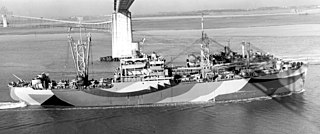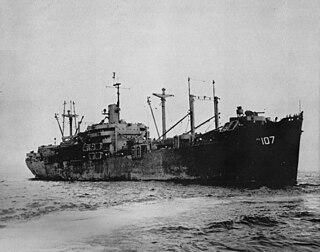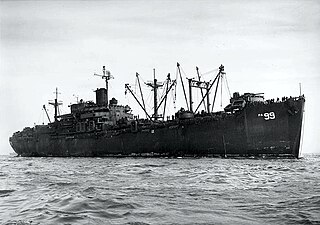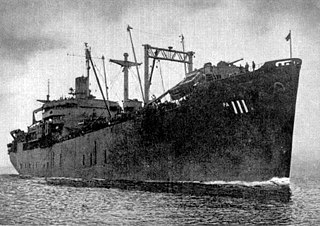
USS Talladega (APA/LPA-208) was a Haskell-class attack transport of the US Navy. She was of the VC2-S-AP5 Victory ship design type. Talladega was named for Talladega County, Alabama.

USS De Grasse (AP-164/AK-223), originally SS Nathaniel J. Wyeth, was a Crater-class cargo ship active with the United States Navy during World War II. It was the second ship of the Navy to bear the name De Grasse, named after French Admiral François Joseph Paul de Grasse.

USS Ottawa (AKA-101) was a Tolland-class attack cargo ship in service with the United States Navy from 1945 to 1947. She was sold into commercial service and was lost in 1951.

USS Tate (AKA-70) was a Tolland-class attack cargo ship in service with the United States Navy from 1944 to 1946. She was sold into commercial service and was scrapped in 1970.

USS Waukesha (AKA-84) was a Tolland-class attack cargo ship in service with the United States Navy from 1945 to 1946. She was sold into commercial service and was scrapped in 1970.

USS Lanier (APA-125) was a Haskell-class attack transport in service with the United States Navy from 1944 to 1946. She was scrapped in 1973.

USS Arenac (APA-128) was a Haskell-class attack transport in service with the United States Navy from 1945 to 1946. She was scrapped in 1974.

USS Marvin H. McIntyre (APA-129) was a Haskell-class attack transport in service with the United States Navy from 1944 to 1946. She was scrapped in 1973.

USS Braxton (APA-138) was a Haskell-class attack transport in service with the United States Navy from 1944 to 1946. She was scrapped in 1973.

USS Riverside (APA-102) was a Bayfield-class attack transport in service with the United States Navy from 1944 to 1946. In 1948, she was sold into commercial service. She sank in Smyth Channel, Chile, in 1968.

USS Lander (APA/LPA-178) was a Haskell-class attack transport in service with the United States Navy from 1944 to 1946. She was sold for scrapping in 1983.

USS Lamar (APA-47) was a Bayfield-class attack transport in service with the United States Navy from 1943 to 1946. She was sold into commercial service in 1948 and was scrapped in 1971.

USS Bowie (APA-137) was a Haskell-class attack transport in service with the United States Navy from 1944 to 1946. She was scrapped in 1973.

USS Buckingham (APA-141) was a Haskell-class attack transport in service with the United States Navy from 1945 to 1946. She was scrapped in 1974.

USS Gosper (APA-170) was a Haskell-class attack transport in service with the United States Navy from 1944 to 1946. She was scrapped in 1974.

USS Jerauld (APA-174) was a Haskell-class attack transport in service with the United States Navy from 1944 to 1946. She was scrapped in 1974.

USS Goodhue (APA-107) was a Bayfield-class attack transport in service with the United States Navy from 1944 to 1946. She was sold into commercial service in 1947 and was scrapped in 1982.

USS Dade (APA-99) was a Bayfield-class attack transport that served with the United States Navy from 1944 to 1946. in 1947, she was sold into commercial service and was scrapped in 1970.

USS Hampton (APA-115) was a Bayfield-class attack transport that served with the United States Navy from 1945 to 1946. She was old into commercial service in 1947 and was scrapped in 1973.

USS Grundy (APA-111) was a Windsor-class attack transport that served with the United States Navy from 1945 to 1946. She was subsequently sold in to commercial service and was scrapped in 1973.




















